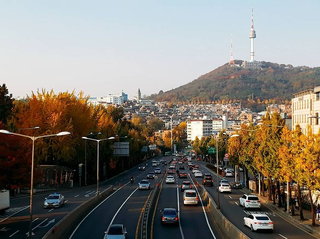
Yongsan District is one of the 25 districts of Seoul, South Korea.

Yeongdeungpo District is an administrative district in southwest Seoul, South Korea. Although the origin of the name is uncertain, the first two syllables are thought to be from "yeongdeung" (靈登) or "divine ascent", a shamanic rite. The third syllable is "po", representing the bank of a river (浦), referring to the district's position on the Han River. The 2006 population was 408,819.
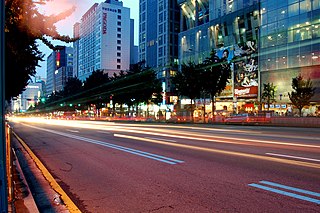
Seodaemun District is one of the 25 districts of Seoul, South Korea.

Seocho District is one of the 25 local government districts which make up the city of Seoul, South Korea. Seocho is a part of the Gangnam region, along with the Gangnam district of Seoul. Seocho District ranks as one of the richest neighborhoods in South Korea and among the most expensive areas in Seoul with an average sales price of 47.75 million South Korean won per 3.3 square meters. Many of the wealthiest residents are concentrated in the three Gangnam districts including Seocho, known as Gangnam School District Eight.

Ichon Station (Korean: 이촌역) is a station in Yongsan District, Seoul on Seoul Subway Line 4 and the Gyeongui–Jungang Line. This station is the closest to the National Museum of Korea, situated in the interior of Yongsan Family Park. It also serves eastern Ichon-dong, home to the largest Japanese community in South Korea with some 1,300 Japanese residents.
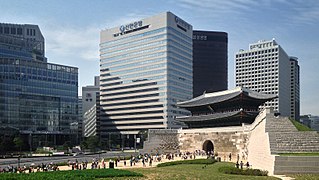
Jung District is one of the 25 districts of Seoul, South Korea.

Yongsan-dong is a ward of Yongsan-gu in Seoul, South Korea.

Hyochang-dong (Korean: 효창동) is a ward of Yongsan District, Seoul, South Korea.

Banpo-dong is a dong, neighborhood of Seocho District, the greater Gangnam area in Seoul, South Korea. Banpo-dong is divided into five different dong which are Banpobon-dong, Banpo 1-dong, 2-dong, 3-dong and 4-dong.

Huam-dong is a dong (neighborhood) of Yongsan District, Seoul, South Korea.

Hannam-dong (Korean: 한남동) is a wealthy dong (neighborhood)of Yongsan District, Seoul, South Korea. It has been portrayed continuously in South Korea's popular culture as an oasis of wealth and luxury, thus becoming the subject of numerous domestic films, television series, and popular music references.

Cheongpa-dong is a dong (neighborhood) of Yongsan District, Seoul, South Korea.
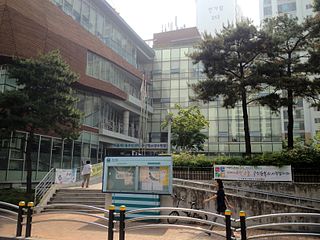
Ichon-dong is a neighborhood of Yongsan District, Seoul, South Korea. It is located in the southwest of the city proper, along the Han River.

Seobinggo-dong is a dong, neighbourhood of Yongsan-gu in Seoul, South Korea. It is directly across the river from Banpo-dong, Seocho-gu, with the Banpo Bridge connecting the two neighbourhoods.

Bogwang-dong is a dong (neighborhood) of Yongsan District in Seoul, South Korea.
Munbae-dong is a dong, neighbourhood of Yongsan-gu in Seoul, South Korea. It is a legal dong administered under its administrative dong, Hangangno 1-dong
Singye-dong is a dong, neighbourhood of Yongsan-gu in Seoul, South Korea. It is a legal dong administered under its administrative dong, Hangangno 1-dong
Chungjeongno-dong (Korean: 충정로동) is a dong (neighborhood) of Seodaemun District, Seoul, South Korea.
Sangam-dong is a legal dong (neighborhood) of the Mapo District in Seoul, South Korea. In the wake of the 2002 FIFA World Cup, a large apartment complex and DMC business district have been created and developed into the center of western Seoul.
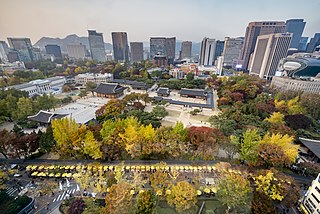
Seoul, officially Seoul Special City, is the capital and largest city of South Korea. The broader Seoul Capital Area, encompassing Gyeonggi province and Incheon Metropolitan City, emerged as the world's sixth largest metropolitan economy in 2022, trailing behind Paris, San Francisco, Los Angeles, Tokyo, and New York, and hosts more than half of South Korea's population. Although Seoul's population peaked at slightly over 10 million, it has gradually decreased since 2014, standing at approximately 9.97 million residents as of 2020. Seoul is the seat of the South Korean government.


















